Ariel Gordon's Blog, page 5
July 22, 2017
TreeTalk-ing at Tallest Poppy!
Winnipeg’s street trees were recently hosts for three infestations: cankerworm, elm spanworm, and tent caterpillars. Which meant most Winnipeggers ate/wore worms for weeks at a time. The worst-hit trees had their leaves eaten down to the stem, which means they’ve spent July growing a new canopy’s worth of leaves…
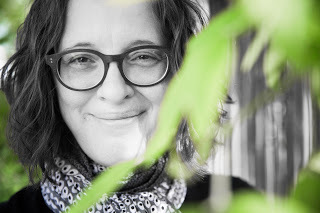
The mature elm outside Tallest Poppy is middle-aged, anywhere from 70 to 100 years old. It’s survived round after round of construction, billows of pollution, drought, even gig posters stapled to it.
In TreeTalk, my Tallest Poppy Residency July 29 & 30, I’ll work with/next to the tree to add a new layer of leaves to our ideas on street trees.
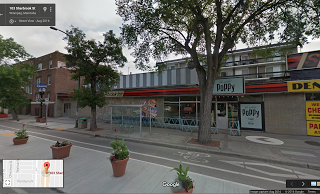 Throughout the weekend, I’ll work on the Tallest Poppy patio, composing snippets of poems which I'lll hang from the tree using paper and string. Passersby will be invited to TreeTalk too — their secrets / one-liners / meditations / haiku will also be hung from the tree.
Throughout the weekend, I’ll work on the Tallest Poppy patio, composing snippets of poems which I'lll hang from the tree using paper and string. Passersby will be invited to TreeTalk too — their secrets / one-liners / meditations / haiku will also be hung from the tree.
Along the way, I’ll will document the leaves via photography. I’ll ask people in her Winnipeg and Canadian networks to add leaves via comments on social media.
By the end of the weekend, the tree will have a new, temporary coat of leaves, as ephemeral/beautiful as the original. It will be infested with words/ideas. I’ll compile all the texts into a found poetry piece, which will be launched at the First Friday After Party at Tallest Poppy on August 4, 2017.
On Sunday, July 30, I’ll hold a one-hour writing workshop, where people are invited to come and TreeTalk, writing poems and letters to the tree.

The mature elm outside Tallest Poppy is middle-aged, anywhere from 70 to 100 years old. It’s survived round after round of construction, billows of pollution, drought, even gig posters stapled to it.
In TreeTalk, my Tallest Poppy Residency July 29 & 30, I’ll work with/next to the tree to add a new layer of leaves to our ideas on street trees.
 Throughout the weekend, I’ll work on the Tallest Poppy patio, composing snippets of poems which I'lll hang from the tree using paper and string. Passersby will be invited to TreeTalk too — their secrets / one-liners / meditations / haiku will also be hung from the tree.
Throughout the weekend, I’ll work on the Tallest Poppy patio, composing snippets of poems which I'lll hang from the tree using paper and string. Passersby will be invited to TreeTalk too — their secrets / one-liners / meditations / haiku will also be hung from the tree. Along the way, I’ll will document the leaves via photography. I’ll ask people in her Winnipeg and Canadian networks to add leaves via comments on social media.
By the end of the weekend, the tree will have a new, temporary coat of leaves, as ephemeral/beautiful as the original. It will be infested with words/ideas. I’ll compile all the texts into a found poetry piece, which will be launched at the First Friday After Party at Tallest Poppy on August 4, 2017.
On Sunday, July 30, I’ll hold a one-hour writing workshop, where people are invited to come and TreeTalk, writing poems and letters to the tree.
Published on July 22, 2017 20:03
June 29, 2017
I've been Manitoba Cooperator-ed!
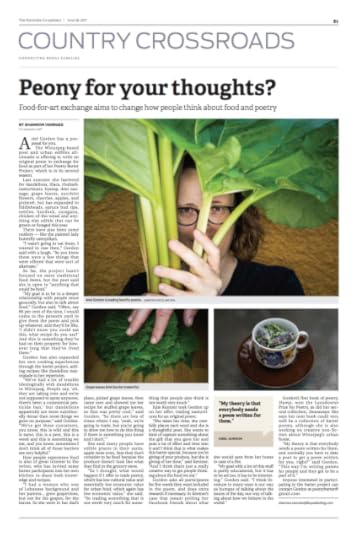
* * *
My thanks to Shannon Vanraes for the interview!
I was also on CBC Information Radio very early on Monday morning, talking about the Poetry Barter Project.
Finally, Bob Armstrong included the project in his Paperchase column in last weekend's Winnipeg Free Press.
Published on June 29, 2017 10:25
May 31, 2017
32 Years in Assiniboine Forest
Published on May 31, 2017 08:46
May 28, 2017
CFS: Poetry Barter Project
For the second summer in a row, I am trading poems for food.
Last year, I traded for lilacs, dandelions, rhubarb, nasturtiums, hyssop, deer sausage, grape leaves, zucchini flowers, cherries, apples, and pickerel.
This year, I am interested in fiddleheads, spruce bud tips, nettles, burdock, caragana, chicken-of-the-woods…and anything else edible that can be grown or foraged in the city.
How does it work? Say you’ve got abundant lilac. You email me at poetrybarter@gmail.com to say you’d trade a vaseful for a poem. You provide me with 5 words to use in the poem: dinosaur, birds, love, childless, peace. In a week's time, I visit your house/apartment/garden plot, pick a bouquet of lilac, and hand over a fresh poem.
About me:
Ariel Gordon is a Winnipeg writer. Her first book of poetry, Hump(Palimpsest Press, 2010), won the Lansdowne Prize for Poetry at the Manitoba Book Awards, as did her second collection, Stowaways(2014). She is currently working on creative non-fiction about Winnipeg’s urban forest, slated for publication with Wolsak & Wynn in 2018.
Deadline: October 31, or when frost kills everything.
So, who has lilac/fiddleheads/nettles/mushrooms/etc and NEEDS a poem written just for them?
Last year, I traded for lilacs, dandelions, rhubarb, nasturtiums, hyssop, deer sausage, grape leaves, zucchini flowers, cherries, apples, and pickerel.
This year, I am interested in fiddleheads, spruce bud tips, nettles, burdock, caragana, chicken-of-the-woods…and anything else edible that can be grown or foraged in the city.
How does it work? Say you’ve got abundant lilac. You email me at poetrybarter@gmail.com to say you’d trade a vaseful for a poem. You provide me with 5 words to use in the poem: dinosaur, birds, love, childless, peace. In a week's time, I visit your house/apartment/garden plot, pick a bouquet of lilac, and hand over a fresh poem.
About me:
Ariel Gordon is a Winnipeg writer. Her first book of poetry, Hump(Palimpsest Press, 2010), won the Lansdowne Prize for Poetry at the Manitoba Book Awards, as did her second collection, Stowaways(2014). She is currently working on creative non-fiction about Winnipeg’s urban forest, slated for publication with Wolsak & Wynn in 2018.
Deadline: October 31, or when frost kills everything.
So, who has lilac/fiddleheads/nettles/mushrooms/etc and NEEDS a poem written just for them?
Published on May 28, 2017 12:00
May 27, 2017
Nature writing at Oak Hammock Marsh
So I taught a nature writing workshop today at Oak Hammock Marsh.
I don't always like teaching creative writing. It requires a lot of preparation time that is stolen from my writing time and, of course, the workshops themselves can be stressful.
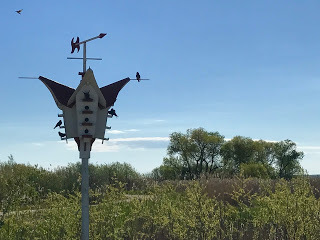 But today's class was wonderful. The participants were pleased to be there and happy to try anything. They'd all been writing long enough that they weren't shy about sharing their first drafts or commenting on other people's drafts.
But today's class was wonderful. The participants were pleased to be there and happy to try anything. They'd all been writing long enough that they weren't shy about sharing their first drafts or commenting on other people's drafts.
It helped, I supposed, that I was teaching a subject that I love. And that we were looking out on the marsh, with all the birds calling, with the wind blowing through last year's cattails. Children tromping on the boardwalk, a red canoe full of people setting off, birders with their big cameras and upscale camo.
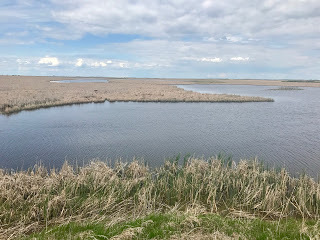 We ended the workshop by peering at a large tree on the edge of the parking lot. I mistakenly identified it as a balsam poplar but later learned it was a cottonwood; luckily, the exercize wasn't dependent on a correct ID.
We ended the workshop by peering at a large tree on the edge of the parking lot. I mistakenly identified it as a balsam poplar but later learned it was a cottonwood; luckily, the exercize wasn't dependent on a correct ID.
We started near the base of the tree, wrote for a few minutes, then took two steps back, wrote, stepped back, wrote...
It was the simplest of exercizes but it had such a strong effect. At first, all we could see was the gnarled bark and the wire fencing wound around the trunk. As we stepped backwards, we contemplated the tree's waxen leaves, how there was a clump of small black caterpillars on a cluster of leaves. Finally, we noticed the beautiful oval shape of the tree, how it was set between the marsh and the parking lot.
As we walked back towards the interpretive centre, we saw two black Clydesdales with a sleigh behind them. Children were climbing up the ramp into the sleigh, which soon set out, making a loop around the marsh.
Having said my goodbyes, I got on the next sleigh ride, listening to the driver give a history of Oak Hammock and, when that was done, walked a slightly longer loop than the one we'd just ridden along.
It was 4 pm by the time I left, gritty with sun and birdsong, and I had the great good fortune to go straight to a friend's garden, where he traded me lovage and mint for poems, as part of my Poetry Barter Project.
What a day! (I napped for four hours when I got home...)
I don't always like teaching creative writing. It requires a lot of preparation time that is stolen from my writing time and, of course, the workshops themselves can be stressful.
 But today's class was wonderful. The participants were pleased to be there and happy to try anything. They'd all been writing long enough that they weren't shy about sharing their first drafts or commenting on other people's drafts.
But today's class was wonderful. The participants were pleased to be there and happy to try anything. They'd all been writing long enough that they weren't shy about sharing their first drafts or commenting on other people's drafts.It helped, I supposed, that I was teaching a subject that I love. And that we were looking out on the marsh, with all the birds calling, with the wind blowing through last year's cattails. Children tromping on the boardwalk, a red canoe full of people setting off, birders with their big cameras and upscale camo.
 We ended the workshop by peering at a large tree on the edge of the parking lot. I mistakenly identified it as a balsam poplar but later learned it was a cottonwood; luckily, the exercize wasn't dependent on a correct ID.
We ended the workshop by peering at a large tree on the edge of the parking lot. I mistakenly identified it as a balsam poplar but later learned it was a cottonwood; luckily, the exercize wasn't dependent on a correct ID.We started near the base of the tree, wrote for a few minutes, then took two steps back, wrote, stepped back, wrote...
It was the simplest of exercizes but it had such a strong effect. At first, all we could see was the gnarled bark and the wire fencing wound around the trunk. As we stepped backwards, we contemplated the tree's waxen leaves, how there was a clump of small black caterpillars on a cluster of leaves. Finally, we noticed the beautiful oval shape of the tree, how it was set between the marsh and the parking lot.
As we walked back towards the interpretive centre, we saw two black Clydesdales with a sleigh behind them. Children were climbing up the ramp into the sleigh, which soon set out, making a loop around the marsh.
Having said my goodbyes, I got on the next sleigh ride, listening to the driver give a history of Oak Hammock and, when that was done, walked a slightly longer loop than the one we'd just ridden along.
It was 4 pm by the time I left, gritty with sun and birdsong, and I had the great good fortune to go straight to a friend's garden, where he traded me lovage and mint for poems, as part of my Poetry Barter Project.
What a day! (I napped for four hours when I got home...)
Published on May 27, 2017 18:45
April 7, 2017
The Pas in April

* * *
I'll be doing two workshops and two readings as part of the UCN Language Arts Festival.
Once the festival is complete, I'll be doing a reading on April 27 at the Pas Public Library with Lauren and Duncan as part of National Poetry Month.
I'm grateful for organizers Keith Hyde and David Williamson for all their work and the University College of the North and the League of Canadian Poets for their support.
Published on April 07, 2017 14:47
March 19, 2017
NPM in the WFP 2017
For the second year in a row, The Winnipeg Free Press will be hosting a National Poetry Month project.
Every Saturday in April, poems by Winnipeg writers will appear in the 49.8 section.
Eligible writers: Winnipeg writers. NPM in the WFP is committed to a diversity of voices: emerging, PoC, spoken word, Indigenous, established, LGBTQ+, and page poets. If your work was featured in the 2016 edition of NPM on the WFP, you may still submit, but the priority will be new writers.
Details: Email previously unpublished poems on the theme of “Time” to poetrymonthwfp@gmail.com The DEADLINE for submissions is March 25, 2017. Submit a maximum of 5 poems. Each poem should be no more than 25 lines. Please submit your poems in one Word document (PDF or RTF also acceptable). Send a short bio (max 40 words), both in the body of the email AND in your submission.
About the Editor: Ariel Gordon is a Winnipeg writer. Her second collection of poetry, Stowaways (Palimpsest Press, 2014), won the 2015 Lansdowne Prize for Poetry. She is currently writing creative non-fiction about Winnipeg’s urban forest, which is slated for publication in 2018 with Wolsak & Wynn.
Every Saturday in April, poems by Winnipeg writers will appear in the 49.8 section.
Eligible writers: Winnipeg writers. NPM in the WFP is committed to a diversity of voices: emerging, PoC, spoken word, Indigenous, established, LGBTQ+, and page poets. If your work was featured in the 2016 edition of NPM on the WFP, you may still submit, but the priority will be new writers.
Details: Email previously unpublished poems on the theme of “Time” to poetrymonthwfp@gmail.com The DEADLINE for submissions is March 25, 2017. Submit a maximum of 5 poems. Each poem should be no more than 25 lines. Please submit your poems in one Word document (PDF or RTF also acceptable). Send a short bio (max 40 words), both in the body of the email AND in your submission.
About the Editor: Ariel Gordon is a Winnipeg writer. Her second collection of poetry, Stowaways (Palimpsest Press, 2014), won the 2015 Lansdowne Prize for Poetry. She is currently writing creative non-fiction about Winnipeg’s urban forest, which is slated for publication in 2018 with Wolsak & Wynn.
Published on March 19, 2017 22:40
March 4, 2017
In Conversation: Brian McInnes
Winnipeg Free Press—PRINT EDITION
by Ariel Gordon
Brian McInnes is an Ojibwa Anishinaabe education professor at the University of Minnesota Duluth. He is also the great-grandson of Francis Pegahmagabow, Canada’s most-decorated indigenous soldier, chief of his community, and supreme chief of the National Indian Government.
Brian will be launching Sounding Thunder: The Stories of Francis Pegahmagabow on March 7 at McNally’s.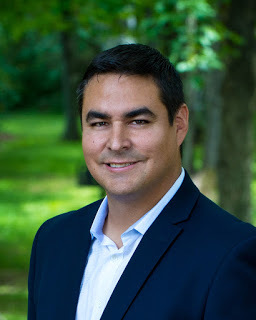
Free Press: What do you want people to know about Sounding Thunder?
Brian McInnes: I would like people to know that Sounding Thunder, while of clear interest for indigenous peoples and communities, is a story for all Canadians. Although the book features several stories of military legend and political hero Francis Pegahmagabow, it is not meant to serve as "his story" in the biographical sense. Sounding Thunder provides us all with a greater understanding of the history of his people, the Ojibwa worldview, and the major life experiences that made Francis the extraordinary individual he was.
FP: In addition to these public roles, Francis Pegahmagabow was also your great-grandfather. Did you feel any extra responsibility when writing this book?
BM: Absolutely! His contributions to Canadian history alone warrant a special degree of care and description. He is a significantly under-recognized Canadian figure, and the timing seemed right to release this book on the eve of Canada’s 150th anniversary. Francis was never recognized as a citizen in his lifetime but his contributions to Canadian society deserve commendation in this time of remembrance and celebration of the efforts of all peoples in making Canada what it is today. The book also provided a much-needed opportunity to gently correct some of the misinterpretations in the written record that marred his legacy.
FP: Why was it important for Francis’ stories to appear in both Ojibwa and English?
BM: In the contemporary movement to recognize indigenous languages as official languages of Canada, materials that first feature a native language should be of increasing value. I spend a considerable amount of the book explaining how language is central to identity, and how native languages and storytelling traditions have much to offer our collective understanding of the world. The book includes at least two maps that document some of the first place names for one of Canada’s most beautiful regions. The stories in (the book) are based on a number of stories that Francis told his youngest children, and that they encouraged me to share with the world. It was their wish that these stories be told first in the native language and I have honoured that request in this book.
FP: What are your goals for Sounding Thunder?
BM: I wanted Sounding Thunder to be a book that would bring a deeper appreciation for the historic contributions and often unseen struggles of indigenous peoples in Canada. In creating a more common understanding amongst Canadians about the past experience of native peoples, we have a better chance of creating a future that is characterized by reconciliation and positive relationship.
FP: You live in Duluth, teaching at the University of Minnesota. Is it difficult to live and work far away from the land and waters of Georgian Bay and your home community?
BM: I feel very lucky to be where I am but the connection to home is undeniable and ever-present. When I was a young man, my great aunt took me to a special place on Georgian Bay—the Turtle rock—(close to the birthplace of Francis Pegahmagabow) and told me it was a marker that the Ojibwa Nation had used in their migration westward. That moment somewhat directed me to where I presently am, particularly with my interest in traditional Ojibwa ceremonial traditions. Lake Superior is a pretty special place, and its connection to Lake Huron is very real. This end of Ojibwa country, fortunately, has a sense of resonance and familiarity that makes home seem not so far away.
Ariel Gordon is a Winnipeg writer.
by Ariel Gordon
Brian McInnes is an Ojibwa Anishinaabe education professor at the University of Minnesota Duluth. He is also the great-grandson of Francis Pegahmagabow, Canada’s most-decorated indigenous soldier, chief of his community, and supreme chief of the National Indian Government.
Brian will be launching Sounding Thunder: The Stories of Francis Pegahmagabow on March 7 at McNally’s.

Free Press: What do you want people to know about Sounding Thunder?
Brian McInnes: I would like people to know that Sounding Thunder, while of clear interest for indigenous peoples and communities, is a story for all Canadians. Although the book features several stories of military legend and political hero Francis Pegahmagabow, it is not meant to serve as "his story" in the biographical sense. Sounding Thunder provides us all with a greater understanding of the history of his people, the Ojibwa worldview, and the major life experiences that made Francis the extraordinary individual he was.

FP: In addition to these public roles, Francis Pegahmagabow was also your great-grandfather. Did you feel any extra responsibility when writing this book?
BM: Absolutely! His contributions to Canadian history alone warrant a special degree of care and description. He is a significantly under-recognized Canadian figure, and the timing seemed right to release this book on the eve of Canada’s 150th anniversary. Francis was never recognized as a citizen in his lifetime but his contributions to Canadian society deserve commendation in this time of remembrance and celebration of the efforts of all peoples in making Canada what it is today. The book also provided a much-needed opportunity to gently correct some of the misinterpretations in the written record that marred his legacy.
FP: Why was it important for Francis’ stories to appear in both Ojibwa and English?
BM: In the contemporary movement to recognize indigenous languages as official languages of Canada, materials that first feature a native language should be of increasing value. I spend a considerable amount of the book explaining how language is central to identity, and how native languages and storytelling traditions have much to offer our collective understanding of the world. The book includes at least two maps that document some of the first place names for one of Canada’s most beautiful regions. The stories in (the book) are based on a number of stories that Francis told his youngest children, and that they encouraged me to share with the world. It was their wish that these stories be told first in the native language and I have honoured that request in this book.
FP: What are your goals for Sounding Thunder?
BM: I wanted Sounding Thunder to be a book that would bring a deeper appreciation for the historic contributions and often unseen struggles of indigenous peoples in Canada. In creating a more common understanding amongst Canadians about the past experience of native peoples, we have a better chance of creating a future that is characterized by reconciliation and positive relationship.
FP: You live in Duluth, teaching at the University of Minnesota. Is it difficult to live and work far away from the land and waters of Georgian Bay and your home community?
BM: I feel very lucky to be where I am but the connection to home is undeniable and ever-present. When I was a young man, my great aunt took me to a special place on Georgian Bay—the Turtle rock—(close to the birthplace of Francis Pegahmagabow) and told me it was a marker that the Ojibwa Nation had used in their migration westward. That moment somewhat directed me to where I presently am, particularly with my interest in traditional Ojibwa ceremonial traditions. Lake Superior is a pretty special place, and its connection to Lake Huron is very real. This end of Ojibwa country, fortunately, has a sense of resonance and familiarity that makes home seem not so far away.
Ariel Gordon is a Winnipeg writer.
Published on March 04, 2017 15:58
February 25, 2017
In Conversation: Terry O’Reilly
Winnipeg Free Press—PRINT EDITION
by Ariel Gordon
Former adman Terry O’Reilly has spent the last 10 years on CBC Radio, talking about advertising and then the broader world of marketing.
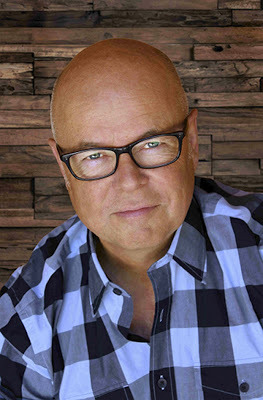 He is launching his second book, This I Know: Marketing Lessons from Under the Influence, on Monday at McNally’s.
He is launching his second book, This I Know: Marketing Lessons from Under the Influence, on Monday at McNally’s.
Free Press: What do you want people to know about This I Know?
O’Reilly: I wrote this book for one very specific reason. Most of the companies in this country are small to medium-sized businesses. Almost none of them have a big advertising agency on speed dial. This book gives entrepreneurs the kind of high-level marketing thinking they normally wouldn’t have access to. From how to analyze your greatest marketing opportunity, to crafting a killer strategy, to why going the extra inch might be smarter than going the extra mile, then how to take all that thinking and turn it into compelling marketing. I hope this book becomes a very well-thumbed companion.
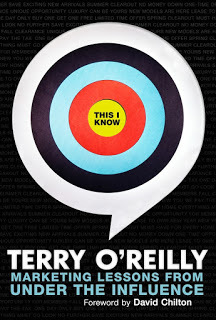 FP: First, you worked at an ad agency. Then you created Pirate Radio & Television, a company that produced radio and television commercials for ad agencies. Then you started one radio show for CBC, and then another, looking first at advertising and then marketing.
FP: First, you worked at an ad agency. Then you created Pirate Radio & Television, a company that produced radio and television commercials for ad agencies. Then you started one radio show for CBC, and then another, looking first at advertising and then marketing.
It looks like a logical progression from the outside. What did it feel like on the inside?
O’Reilly: I just read UFC fighter Georges St. Pierre’s fantastic book The Way of The Fight. He maintains a "white-belt mentality." In other words, he’s always in learning mode. I’ve been in the advertising business for over 35 years, worked on over 10,000 commercials, and I’m still learning. Each career step was a weigh station. The stakes got bigger. The lessons more vivid. The epiphanies more surprising. This book is a collection of that accumulated wisdom — so far.
FP: What was your favourite campaign that you created? What’s your favourite campaign by someone else?
O’Reilly: My favourite campaign was for the Toronto Symphony Orchestra. They desperately needed to attract younger subscribers. With only a tiny budget, I wrote a radio campaign that generated more subscriptions in a few months than they had received in the entire previous year. And did it with a highly unusual campaign. Proving (again) that creativity is a powerful business tool.
My favourite advertising campaign of all time was the Volkswagen advertising of the 1960s. Created by ad agency Doyle Dane Bernbach, they took a small, ugly, underpowered German car in a post World War II world and turned it into the most beloved automobile of its time. They did it with wit and self-deprecating advertising. It had never been done before. Best advertising of all time.
FP: What would be your first tip for small business owners? For young people getting into marketing?
O’Reilly: Decide what business you are really in. Molson isn’t in the beer business, it’s in the party business. Goodyear isn’t in the tire business, it’s in the safety business. Whitewater rafting companies aren’t in the personal transportation business, they’re in the personal transformation business. Until you really know what people are buying, you’re marketing will never be relevant. As someone once said, people don’t buy three-quarter-inch drill bits, they buy three-quarter inch holes.
I would tell any young person getting into the marketing business to read. Read great business books. Read great marketing blogs. Pour over advertising award annuals. Be a thirsty sponge. The lessons are many as long as you have your antennae finely tuned.
FP: How is social media affecting traditional advertising, like print and broadcast media?
O’Reilly: Every year, more and more advertising money is being plowed into social media. It’s a conversation. Most traditional media is a one-way monologue. It has to figure out a way to co-exist with social media. When radio appeared in the 1920s, many said it was the end of newspapers. But papers got smart and started printing the radio program schedules. It learned to co-exist. Traditional media has to redefine itself, too.
FP: What are you reading right now? What are you writing right now?
O’Reilly: I have two books on the go. One is The Case For Creativity by James Hurman. It proves that award-winning advertisements outperform non-award winning work by 300-400 per cent. That’s important, because most clients think award shows are useless. That is an uninformed point-of-view. The other book I’m reading is Five Presidents by Clint Hill. He was the secret service agent who jumped onto the back of the limo the day JFK was assassinated. He worked for five different Presidents. Fascinating to read the differences.
A weekly radio show/podcast is a cruel mistress. During the run of show (January to June), my writing is consumed and confined to the program. It’s a seven-day-a-week proposition during that period. But I love it. It’s "joyful stress."
Ariel Gordon is a Winnipeg writer.
by Ariel Gordon
Former adman Terry O’Reilly has spent the last 10 years on CBC Radio, talking about advertising and then the broader world of marketing.
 He is launching his second book, This I Know: Marketing Lessons from Under the Influence, on Monday at McNally’s.
He is launching his second book, This I Know: Marketing Lessons from Under the Influence, on Monday at McNally’s.Free Press: What do you want people to know about This I Know?
O’Reilly: I wrote this book for one very specific reason. Most of the companies in this country are small to medium-sized businesses. Almost none of them have a big advertising agency on speed dial. This book gives entrepreneurs the kind of high-level marketing thinking they normally wouldn’t have access to. From how to analyze your greatest marketing opportunity, to crafting a killer strategy, to why going the extra inch might be smarter than going the extra mile, then how to take all that thinking and turn it into compelling marketing. I hope this book becomes a very well-thumbed companion.
 FP: First, you worked at an ad agency. Then you created Pirate Radio & Television, a company that produced radio and television commercials for ad agencies. Then you started one radio show for CBC, and then another, looking first at advertising and then marketing.
FP: First, you worked at an ad agency. Then you created Pirate Radio & Television, a company that produced radio and television commercials for ad agencies. Then you started one radio show for CBC, and then another, looking first at advertising and then marketing. It looks like a logical progression from the outside. What did it feel like on the inside?
O’Reilly: I just read UFC fighter Georges St. Pierre’s fantastic book The Way of The Fight. He maintains a "white-belt mentality." In other words, he’s always in learning mode. I’ve been in the advertising business for over 35 years, worked on over 10,000 commercials, and I’m still learning. Each career step was a weigh station. The stakes got bigger. The lessons more vivid. The epiphanies more surprising. This book is a collection of that accumulated wisdom — so far.
FP: What was your favourite campaign that you created? What’s your favourite campaign by someone else?
O’Reilly: My favourite campaign was for the Toronto Symphony Orchestra. They desperately needed to attract younger subscribers. With only a tiny budget, I wrote a radio campaign that generated more subscriptions in a few months than they had received in the entire previous year. And did it with a highly unusual campaign. Proving (again) that creativity is a powerful business tool.
My favourite advertising campaign of all time was the Volkswagen advertising of the 1960s. Created by ad agency Doyle Dane Bernbach, they took a small, ugly, underpowered German car in a post World War II world and turned it into the most beloved automobile of its time. They did it with wit and self-deprecating advertising. It had never been done before. Best advertising of all time.
FP: What would be your first tip for small business owners? For young people getting into marketing?
O’Reilly: Decide what business you are really in. Molson isn’t in the beer business, it’s in the party business. Goodyear isn’t in the tire business, it’s in the safety business. Whitewater rafting companies aren’t in the personal transportation business, they’re in the personal transformation business. Until you really know what people are buying, you’re marketing will never be relevant. As someone once said, people don’t buy three-quarter-inch drill bits, they buy three-quarter inch holes.
I would tell any young person getting into the marketing business to read. Read great business books. Read great marketing blogs. Pour over advertising award annuals. Be a thirsty sponge. The lessons are many as long as you have your antennae finely tuned.
FP: How is social media affecting traditional advertising, like print and broadcast media?
O’Reilly: Every year, more and more advertising money is being plowed into social media. It’s a conversation. Most traditional media is a one-way monologue. It has to figure out a way to co-exist with social media. When radio appeared in the 1920s, many said it was the end of newspapers. But papers got smart and started printing the radio program schedules. It learned to co-exist. Traditional media has to redefine itself, too.
FP: What are you reading right now? What are you writing right now?
O’Reilly: I have two books on the go. One is The Case For Creativity by James Hurman. It proves that award-winning advertisements outperform non-award winning work by 300-400 per cent. That’s important, because most clients think award shows are useless. That is an uninformed point-of-view. The other book I’m reading is Five Presidents by Clint Hill. He was the secret service agent who jumped onto the back of the limo the day JFK was assassinated. He worked for five different Presidents. Fascinating to read the differences.
A weekly radio show/podcast is a cruel mistress. During the run of show (January to June), my writing is consumed and confined to the program. It’s a seven-day-a-week proposition during that period. But I love it. It’s "joyful stress."
Ariel Gordon is a Winnipeg writer.
Published on February 25, 2017 15:48
February 12, 2017
In Conversation: Eden Robinson
Winnipeg Free Press—PRINT EDITION
Reviewed by Ariel Gordon
Eden Robinson is a Haisla/Heiltsuk writer based in Kitimaat, B.C.
In November, she was given the 2016 Writers’ Trust Engel/Findley Award, which recognizes mid-career writers for a remarkable body of work.

The most recognizable of Robinson’s five books is her Giller-shortlisted first novel, Monkey Beach. The Washington Post called it a "spiritual mystery" for the way it combined the supernatural — based on Haisla culture, of course — with a dark, pop-culture infused murder mystery.
Her latest book, Son of a Trickster, is the first of a projected trilogy. It is the story of Jared, a smart-alecky teenage boy whose emerging supernatural powers are interfering with a home life that includes a single mother with a drug-dealing boyfriend, a flatulent pit bull and a father whose bills he pays.
Robinson will launch Son a Trickster Feb. 12 at McNally Robinson. The event will be hosted by NCI-FM’s David McLeod.
FP: Your books explore addiction and dysfunction; they’re bleak and irreverent while also focusing on indigenous culture and spirituality. They’re also so unexpectedly tender.
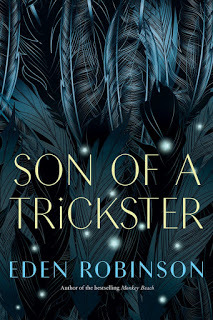 EDEN ROBINSON: Our society has such a stigma about people coping with mental trauma. It makes us uncomfortable, so we don’t want to talk about it. We don’t provide affordable, easily accessible services, yet we expect people to stiff upper lip through absolute hell, and then we dump on them when their lives fall apart because the only relief they can find is through drugs or alcohol. You see it with residential school survivors. You see it with soldiers with PTSD. You see it with first responders. The hard work of healing is done by the traumatized and their families, often with no training and no support. Amazing, resilient people rise out of this, but a lot of good people are crushed.
EDEN ROBINSON: Our society has such a stigma about people coping with mental trauma. It makes us uncomfortable, so we don’t want to talk about it. We don’t provide affordable, easily accessible services, yet we expect people to stiff upper lip through absolute hell, and then we dump on them when their lives fall apart because the only relief they can find is through drugs or alcohol. You see it with residential school survivors. You see it with soldiers with PTSD. You see it with first responders. The hard work of healing is done by the traumatized and their families, often with no training and no support. Amazing, resilient people rise out of this, but a lot of good people are crushed.
FP: What are your goals, your hopes, when taking on all of these big subjects?
ER: My sympathies are with the people coping with impossible circumstances. But I’m not a big fan of morality tales or telling people what to think. And I miss this TV show called Roseanne. And I love Trickster stories. And I have a random brain. So you mush all that together, and my big hope is that people are entertained by my crazy stories.
FP: What have you learned about your process, four books in?
ER: I pushed myself hard when I was younger and had absolutely no work/life balance. I don’t regret my ambition, but I couldn’t do it again because a) my body would rebel and b) family is too important to put on the back burner. Relaxing about my work habits has led me to enjoy writing again. Darkness still exists in my material because, in my heart of hearts, I’m still a goth girl writing moody poetry in my room. But I hope the sense of joy in creating comes through on the page.
FP: Who are the writers you look to? Who are your influences?
ER: Every book has a different set of challenges, so I look to different writers to use as touch stones and inspiration. For this book: Brown Girl in the Ring, Nalo Hopkinson; When Fox is a Thousand, Larissa Lai; One Good Story That One, Thomas King; Kiss of the Fur Queen, Tomson Highway; Tracks, Louise Erdrich; The Hitchhiker’s Guide to the Galaxy, Douglas Adams; Celia’s Story, Lee Maracle; Lyric Philosophy, Jan Zwicky, Indigenous Poetics, Ed. Neil McLeod; Tales of the Kitamaat, Gordon Robinson.
FP: Your novels are published as literary fiction, but they could easily work as fantasy. Have you ever considered throwing over literary festivals for comic cons?
ER: I would love to be invited to comic cons. I’m a huge indiginerd.
FP: What are you reading right now? What are you writing right now?
ER: I just finished an advanced copy of Claire Cameron’s The Last Neanderthal. She can write warm and fuzzy, and then breath-taking violence, and then cutthroat office politics. I really enjoyed it. Both her female narrators were warriors in their own ways. Last week, I read Railroads and Totem Poles by Janet Rogers. She was the poet laureate for Victoria and is a mesmerizing spoken-word poet. Powerful and witty.
I’m working on Trickster Drift, the sequel to Son of a Trickster. Having accepted his heritage as the son of a witch and a Trickster, Jared decides the best way to cope is to become a medical sonographer and argue with his friends about which actor made the best Doctor Who. Since he hasn’t got a lot of savings or funding, he ends up couch surfing in Vancouver with his aunt, Mavis Moody, an eccentric writer and activist. Not based on anyone. Total fiction.
Ariel Gordon is a Winnipeg writer.
Reviewed by Ariel Gordon
Eden Robinson is a Haisla/Heiltsuk writer based in Kitimaat, B.C.
In November, she was given the 2016 Writers’ Trust Engel/Findley Award, which recognizes mid-career writers for a remarkable body of work.

The most recognizable of Robinson’s five books is her Giller-shortlisted first novel, Monkey Beach. The Washington Post called it a "spiritual mystery" for the way it combined the supernatural — based on Haisla culture, of course — with a dark, pop-culture infused murder mystery.
Her latest book, Son of a Trickster, is the first of a projected trilogy. It is the story of Jared, a smart-alecky teenage boy whose emerging supernatural powers are interfering with a home life that includes a single mother with a drug-dealing boyfriend, a flatulent pit bull and a father whose bills he pays.
Robinson will launch Son a Trickster Feb. 12 at McNally Robinson. The event will be hosted by NCI-FM’s David McLeod.
FP: Your books explore addiction and dysfunction; they’re bleak and irreverent while also focusing on indigenous culture and spirituality. They’re also so unexpectedly tender.
 EDEN ROBINSON: Our society has such a stigma about people coping with mental trauma. It makes us uncomfortable, so we don’t want to talk about it. We don’t provide affordable, easily accessible services, yet we expect people to stiff upper lip through absolute hell, and then we dump on them when their lives fall apart because the only relief they can find is through drugs or alcohol. You see it with residential school survivors. You see it with soldiers with PTSD. You see it with first responders. The hard work of healing is done by the traumatized and their families, often with no training and no support. Amazing, resilient people rise out of this, but a lot of good people are crushed.
EDEN ROBINSON: Our society has such a stigma about people coping with mental trauma. It makes us uncomfortable, so we don’t want to talk about it. We don’t provide affordable, easily accessible services, yet we expect people to stiff upper lip through absolute hell, and then we dump on them when their lives fall apart because the only relief they can find is through drugs or alcohol. You see it with residential school survivors. You see it with soldiers with PTSD. You see it with first responders. The hard work of healing is done by the traumatized and their families, often with no training and no support. Amazing, resilient people rise out of this, but a lot of good people are crushed.FP: What are your goals, your hopes, when taking on all of these big subjects?
ER: My sympathies are with the people coping with impossible circumstances. But I’m not a big fan of morality tales or telling people what to think. And I miss this TV show called Roseanne. And I love Trickster stories. And I have a random brain. So you mush all that together, and my big hope is that people are entertained by my crazy stories.
FP: What have you learned about your process, four books in?
ER: I pushed myself hard when I was younger and had absolutely no work/life balance. I don’t regret my ambition, but I couldn’t do it again because a) my body would rebel and b) family is too important to put on the back burner. Relaxing about my work habits has led me to enjoy writing again. Darkness still exists in my material because, in my heart of hearts, I’m still a goth girl writing moody poetry in my room. But I hope the sense of joy in creating comes through on the page.
FP: Who are the writers you look to? Who are your influences?
ER: Every book has a different set of challenges, so I look to different writers to use as touch stones and inspiration. For this book: Brown Girl in the Ring, Nalo Hopkinson; When Fox is a Thousand, Larissa Lai; One Good Story That One, Thomas King; Kiss of the Fur Queen, Tomson Highway; Tracks, Louise Erdrich; The Hitchhiker’s Guide to the Galaxy, Douglas Adams; Celia’s Story, Lee Maracle; Lyric Philosophy, Jan Zwicky, Indigenous Poetics, Ed. Neil McLeod; Tales of the Kitamaat, Gordon Robinson.
FP: Your novels are published as literary fiction, but they could easily work as fantasy. Have you ever considered throwing over literary festivals for comic cons?
ER: I would love to be invited to comic cons. I’m a huge indiginerd.
FP: What are you reading right now? What are you writing right now?
ER: I just finished an advanced copy of Claire Cameron’s The Last Neanderthal. She can write warm and fuzzy, and then breath-taking violence, and then cutthroat office politics. I really enjoyed it. Both her female narrators were warriors in their own ways. Last week, I read Railroads and Totem Poles by Janet Rogers. She was the poet laureate for Victoria and is a mesmerizing spoken-word poet. Powerful and witty.
I’m working on Trickster Drift, the sequel to Son of a Trickster. Having accepted his heritage as the son of a witch and a Trickster, Jared decides the best way to cope is to become a medical sonographer and argue with his friends about which actor made the best Doctor Who. Since he hasn’t got a lot of savings or funding, he ends up couch surfing in Vancouver with his aunt, Mavis Moody, an eccentric writer and activist. Not based on anyone. Total fiction.
Ariel Gordon is a Winnipeg writer.
Published on February 12, 2017 10:33



